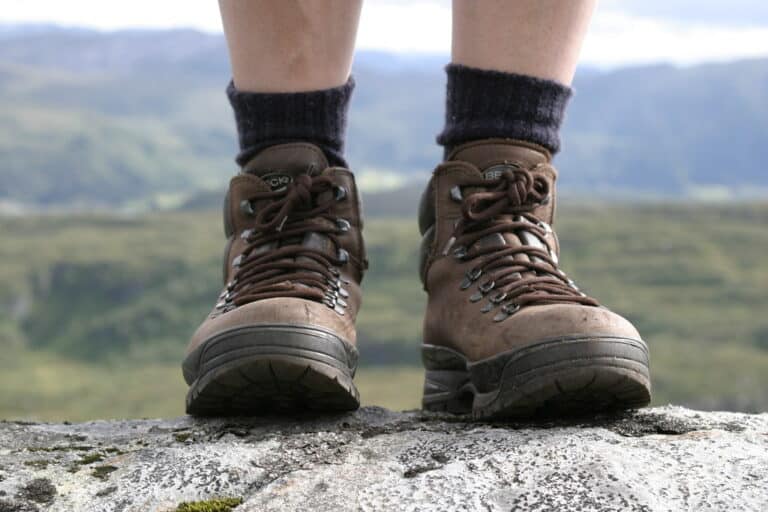Ever wondered, should hiking boots fit snug? It’s a question I’ve grappled with for years. In this article, I’ll share my insights and tips on what makes for the perfect fit.
Hiking boots are not your everyday sneakers. They’re designed for rugged terrains and long treks. That’s why getting the right fit is crucial. Too loose, and you risk blisters; too tight, and you’re in for a world of discomfort.
We’ll explore the balance between snug and comfortable, how to measure your foot for hiking boots, and some common misconceptions about boot fitting. So strap in, and let’s get your feet ready for their next adventure.
The Importance of Proper Fit

The fit of your hiking boot could dictate the success (or failure) of your next outdoor exploration. An ill-fitting pair of boots not only leads to discomfort, but could pose a serious threat to your safety. Blisters, foot pain, poor grip; these are some of the potential issues when you ignore the necessity of a proper fit.
Getting the right fit goes beyond just picking the right size; it’s about taking into account the shape of your foot. Your foot’s width, arch type, and even the shape of your toes, all come into the equation.
So, what does the perfect fit look like? Here’s a clue: it’s that ephemeral balance between snug and comfortable.
Snug doesn’t mean tight. Snug is when the boot hugs your foot just right, without causing discomfort. You should feel secure, with minimal room for your foot to slide or twist around. Yet, it should still accommodate the slight swelling that naturally occurs during long treks.
Comfort, on the other hand, implies that the boot doesn’t cause any hot spots or painful pressure points. Comfort is paramount – but we’re not aiming for the “like walking on clouds” sensation more suitable for a pair of house slippers.
While snug is about stability and structure, comfort speaks to the cushioning and flexibility of the boot. Together, they create that perfect fit we’re after.
Stay tuned for some tips on amping up the snug and upping the comfort factor for your hiking boots.
Finding the Right Balance: Snug vs. Comfortable
Walking into the wilderness, I’ve seen how a shoe can make or break a hiking experience. It all boils down to hitting the tightrope between snug and comfortable when it comes to fitting your boots. Too snug, and you can say hello to blisters. Too loose, and you’re dealing with sliding and tripping troubles all day long.
Understanding foot width, arch type, and toe shape is key to nailing this balance. Every foot is unique and what feels like a heavenly fit to one, might feel like a tight squeeze to another. It’s crucial to recognize the subtleties:
- Foot Width: Standard boot sizes might not work for those with wider or narrower feet. Looking at specialized options can prevent squeezing or large gaps within the boot.
- Arch Type: Flat feet, high arches, low arches – all demand different support levels. Custom insoles can be a game changer here.
- Toe Shape: Boots should not cramp your toes or let them swim freely. The happy medium is having enough room for your toes to move without touching the boot’s front.
Once you’ve met these conditions and you’re basking in the feeling of a good fit, it’s time to understand stability and structure vs. cushioning and flexibility.
Stability and structure factor into the snug element of the boot fit. A boot that provides robust ankle support, reliable lacing system and a secure fit enhances stability, making it snugger. But push it too far, you’re compromising on comfort.
On the other hand, cushioning and flexibility are the lifeblood of comfort in hiking boots. They allow the foot to move naturally and absorb shock. It makes those long miles less arduous. But go overboard, and you’re losing out on the stability, leading to potential injuries.
In the end, it may feel like quite the circus act to balance snug with comfortable, but it’s part of the journey. So remember this the next time you’re boot shopping: achieving that perfect fit isn’t an overnight miracle, it’s a mix of trial, error, and knowing your feet well.
Measuring Your Foot for Hiking Boots

When it comes to hunting for the perfect pair of hiking boots, sizing matters. The first step you need to take even before trying on different forms is to get your foot size right. You don’t want to be halfway through a hike to discover that your boots don’t fit as they should.
One common mistake people make is ignoring their foot width and focusing only on the length. But both components are important. Here’s how do it:
- Measure the length of your foot: Lay a tape measure on the floor and step on it, recording the longest points from your heel to toe.
- Measure the width of your foot: Find the broadest part of your foot, usually right under your toes, and measure that.
Venture with your measurements to a nearby store or use that info while shopping online to choose the right shoe size. Remember, every shoe brand is different. A size 10 in one brand might not equate to a size 10 in another.
Another key thing to note is your arch type. My tip is to carry out the wet foot test. Basically, you wet your foot and step onto a piece of brown paper. Then, observe the imprint. A narrow, curved connection between the ball and heel of your foot indicates a high arch. Conversely, if there’s a broad connection, it signifies a flat foot, meaning you have a low arch.
Besides length, width and arch type, toe shape also plays a role in finding a good fit. Some people have square feet where the big toe and the second toe are almost the same length. If you fall into this category, choose a boot with a square toe box to prevent cramping.
Remember that finding the perfect fit takes time and experimentation just as I’ve previously mentioned. You shouldn’t settle for a boot that just fits okay, aim for that perfect balance between snug and comfortable. Dealing with blisters and foot pain on a hike just isn’t worth it. They ruin the fun and can turn an otherwise great experience into a literal pain.
Debunking Common Misconceptions About Boot Fitting

It seems there’s a good deal of misinformation out there regarding how hiking boots should fit. I am here to debunk these common misconceptions to guide you towards your perfect match.
A frequent misunderstanding I’ve encountered is the belief that a snug boot equals a perfectly fitting boot. While it’s true that a secure fit is vital, a too-tight option may lead to discomfort and even injury. Foot swelling is natural during long hikes and if your boots are too snug, this can cause blisters, corns, or worse.
Many hikers believe that they will ‘break in’ boots that initially feel too tight. While hiking boots do have a break-in period, this should be minimal. If the shoe feels uncomfortable when you first try it on, it’s likely not the right fit. A boot should mostly feel comfortable straight out of the box with minimal areas of tightness which will loosen up after a few wears.
Foot width often gets overlooked. Some argue that as long as the shoe fits lengthwise, you’re good to go. This couldn’t be further from the truth! People often fail to accommodate the full width of their foot, resulting in boots that may be the right length, but fail to fully encase and support your foot because they’re too narrow. This can lead to unnecessary strain and discomfort.
One more misconception is that brand size charts are universal or that your ordinary shoe size will apply to your hiking boot. Sizes may vary drastically among brands and also styles within a brand. While a size 10 may fit just right on a brand A, you may need to size up to a 10.5 or 11 on a brand B.
Keep these debunked misconceptions in mind as you continue your quest for the perfect hiking boots. It’s about more than finding a boot that simply fits – it’s about snagging one that compliments your foot and provides unparalleled comfort and support.
Conclusion: Should Hiking Boots Fit Snug
Let’s set the record straight – snug doesn’t always equate to a perfect fit when it comes to hiking boots. It’s crucial to remember that a boot that’s too tight can cause discomfort and even injuries.
Foot width is just as important as length. Don’t fall into the trap of relying solely on brand size charts – they’re not universal. Trying on different sizes and styles is the key to finding your perfect fit.
Ultimately, the perfect hiking boot is one that fits well, provides comfort, and offers support. So, don’t compromise. Take time to find the right boot for your foot and your hiking adventures will be all the better for it.
Other suggested articles:


